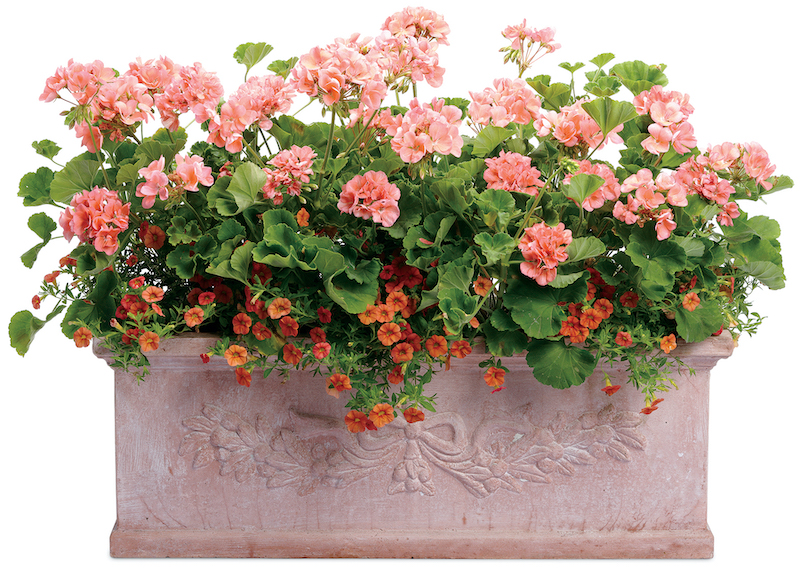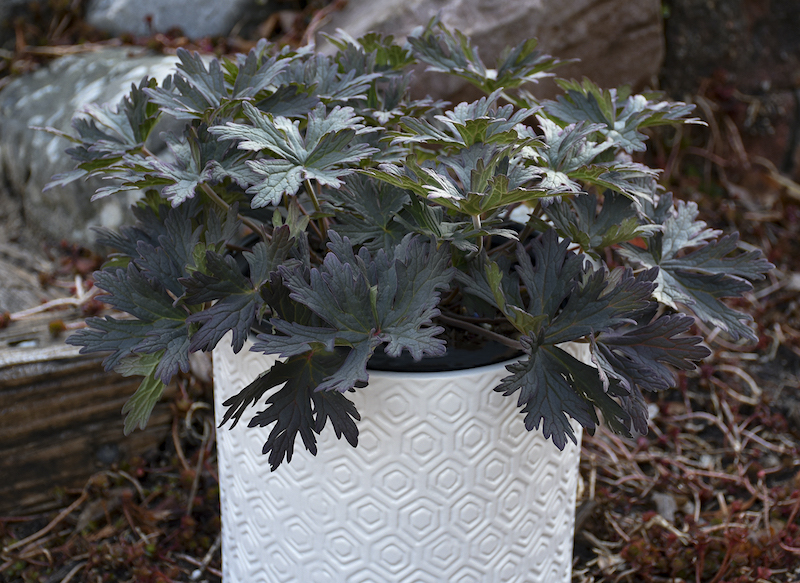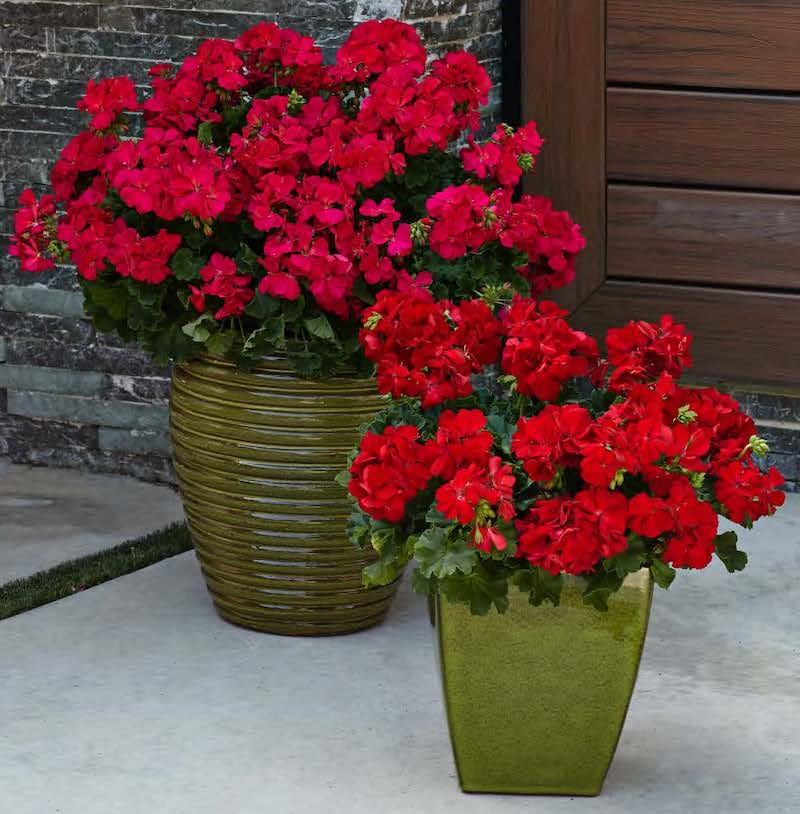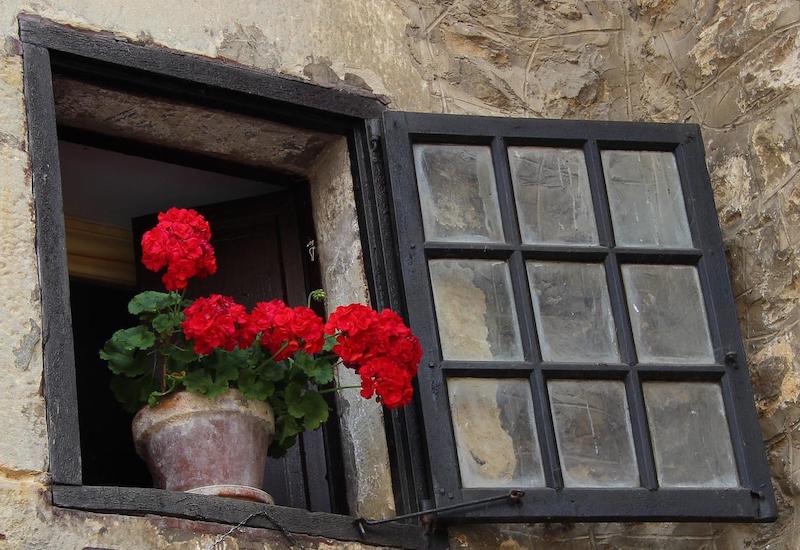Annual geraniums, more accurately known as pelargoniums, make exceptional container plants, serving as the thriller or filler. Their long-lasting blooms can brighten any patio, balcony or entryway. They are stunning when planted in several matching containers, where the colorful swath of flowers can make a big impact. The trailing ivy-leaved pelargoniums are particularly well-suited for growing in hanging baskets. Pelargoniums are not frost hardy, so plants can be tossed in the winter or brought indoors to overwinter.

Perennial geraniums, also known as hardy cranesbill, also grow well in containers and will come back year after year. They require little maintenance beyond dividing and repotting overgrown plants every few years. Hardy cranesbill makes an excellent filler in an unlimited number of great plant combinations.

Planting Geraniums in Pots
The best time to plant annual geraniums in pots is in the spring, when plants send out new growth. The cooler temperatures of spring also help new plants settle in before the heat of summer. Containers of pelargoniums should be placed in a sunny location, with at least 4 hours of direct sun for best blooming potential. Choose a container that is at least 12 inches in diameter, with holes for drainage. Pelargoniums do not appreciate soggy, waterlogged soil, so choose containers that drain well and can be elevated with pot feet.
Perennial geraniums have similar container requirements, although they are less fussy than their annual counterparts. Perennial geraniums can tolerate more shade and moisture than pelargoniums; however, they bloom better in full sun. They form a dense carpet, so choose pots at least 16 inches in diameter with drainage holes.

Best Soil For Geraniums in Pots
Use high-quality potting soil for planting geraniums in containers. Never add rocks to the bottom of containers, which actually reduces drainage. You can top-dress containers with compost to retain moisture and deliver nutrients over time to the soil. Perennial geraniums are more tolerant of poor soil than pelargoniums.
Caring For Geraniums in Planters
Both annual and perennial geraniums are tough container plants that do not require frequent watering and fertilizing. In general, water geranium containers more frequently in the summer when the top inch of soil feels dry. Annual perennials are not hardy in most climates and will need to be protected from frost. You can bring your pelargoniums indoors to overwinter or simply grow them as houseplants.
Watering Geraniums in Pots
Geraniums grown in containers will need to be watered more often than those in the ground because the soil in pots dries out faster. On hot summer days, you may need to water your containers every 2 - 3 days, depending on how much sun and rain the containers get. Geraniums love rainwater, which can be stored in barrels to water your containers during a drought period. Water the plants deeply to saturate the roots. Let the soil dry out a bit between watering sessions, as geraniums can develop root rot in soggy soil.
Fertilizing Geraniums in Pots
Geraniums grown in containers can benefit from regular feeding schedules. Plants in pots will eventually absorb available nutrients and will need nutrients to be replenished each year. You can apply an even layer of high-quality compost to the base of geraniums or use an organic slow-release fertilizer. If using a water-soluble fertilizer, apply it to containers at half strength. Annual geraniums can be fertilized every two weeks during the growing season to encourage prolific blooms. Perennial geraniums only require an annual feeding in the spring or an application of compost.
Winter Care For Geraniums in Pots
During the winter, annual geraniums will need to be brought indoors if you live in climates prone to frost. In the fall, cut the stems back to about 6 to 8 inches. Find a sunny location for your geraniums and keep them cool. They prefer night temperatures around 50° to 60°F. You can reduce watering during the winter, but don’t let the soil dry out completely. Do not feed annual geraniums in the winter while they are resting. In the spring, when the risk of frost has passed, geraniums will start to put on new growth, and you can move plants outside. You can add fertilizer at this point and give plants a few deep soaks to help them wake up.
For perennial geraniums, cut them down to a few inches above the ground in the fall, as they start to die back. Most are hardy in zones 3-9 and require no extra protection in the winter. Choose frost-proof containers that will not crack in cold temperatures. Do not let containers become waterlogged in winter, which can kill even the toughest plants and cause pots to crack.
Growing Geraniums Indoors
Annual geraniums make great houseplants if you have a sunny spot for them with at least 6-8 hours of direct sun. They are often grown indoors in the winter and set outside in the warmer months. The extra sunshine helps them display the best flower show. Geranium houseplants have average water and fertilizer needs. Only water them when the top few inches of soil feel dry, and reduce your watering schedule in the winter. Fertilize in the warmer months, when geraniums are blooming and actively growing.

Hardy geraniums are not the best houseplants due to their spreading habit and dense root system. They require much larger containers than pelargoniums and prefer to spread out in big clumps in the ground.
 |
Author Jessica Mercer - Published 7-04-2022 |
